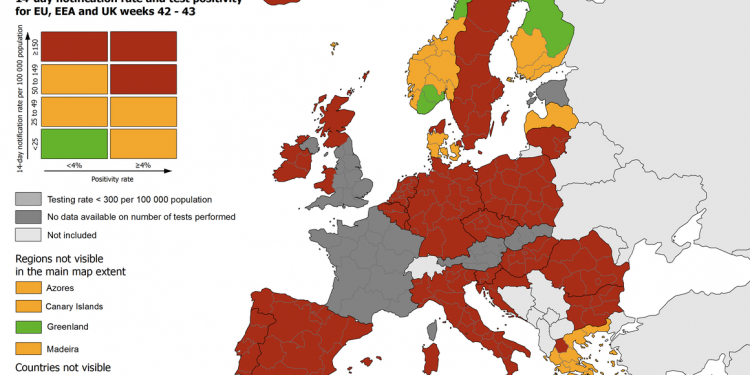More colour codes to keep track of for entry into Denmark

A country can be yellow or orange, banned or open, and now also EU Red or Grey. Each colour defines if foreign residents entering under the worthy clause rule need a COVID-19 test or not.
The article continues below.
By Bente D. Knudsen
Confusion as new COVID-19 restrictions are implemented for travel to Denmark for travellers from the EU, Schengen and the United Kingdom under the “worthy cause rule”.
The worthy cause rule is followed intensely by foreign nationals in Denmark as this is the one allowing visits from amongst other close family, sweethearts, people coming for job interviews, students and a range of other criteria which exempt them from the banned status of their country of residence preventing tourists from entering.
As of 26 October, new colour codes have been introduced, as countries in Europe, Schengen and the United Kingdom can now be high-risk countries with the EU colour code red or grey as defined at an EU meeting on 13 October 2020.
The article continues below.
If they are EU red or grey the Danish institute for infectious diseases, SSI, will classify them as high-risk countries. Find link to the current list here.
Residents from high risk countries, who are able to enter due to one of the worthy cause rules, now need a negative COVID-19 test not more than 72 hours old to be able to enter Denmark.
This colour code is new, as before there was only one for banned countries, the orange colour code on the Foreign Ministry’s list of countries with entry restrictions.
Confused? So are we at Your Danish Life.
The article continues below.
At present there is only one country on the orange list of the Danish Foreign Office (orange means banned for entry to Denmark) which is NOT a high-risk country in the EU definition.
This means that residents from this country, entering under the worthy clause exemption rules, do NOT need at negative COVID-19 test to enter Denmark.
At present (6 November) these countries are:
Finland
The list of high-risk countries is updated weekly and may thus change from one week to the next.
The article continues below.
Understanding the EU classification:
Regions can be green, orange, red or grey (grey when the data is insufficient).
Green: Rate is less than 25 per 100,000 inhabitants and the percentage of positive tests is less than 4 percent.
Orange: Rate is less than 50 per 100,000 inhabitants but the percentage of positive tests is 4 or above, or the rate is between 25 and 150 per 100,000 inhabitants but the percentage of positive tests is below 4 percent.
Red: The rate is 50 or more per 100,000 inhabitants and the percentage of positive tests is 4 percent or more, or the rate is more than 150 per 100,000 inhabitants.
Grey: If there is not enough data or if the rate of testing is at 300 or less.
Countries in the EU, Schengen and the UK are defined as high-risk countries when they are red or grey and thus travellers from these countries who are able to enter under the worthy cause rule are subject to travel restrictions, in Denmark they must present a negative COVID-19 test to enter the country.
The article continues below.
The list is updated every week by the Danish Institute for Infectious diseases, SSI and implemented every Thursday at the same time as the Danish Foreign Office publishes updated travel guidelines which in Denmark can be yellow and orange.
Yellow countries have no travel restrictions, all residents can enter Denmark and Danish residents can travel to a yellow country, an orange country is a banned country, which means that entry is restricted to only those with a worthy cause and Danes are not to travel to a country which is orange.
For entry to Denmark from an orange country, residents need to have a negative COVID-19 test if that orange country is red or grey on the EU classification list.
So dear readers, for visits from family members and sweethearts from the EU, Schengen and the UK, you now need to check if their country of residence is yellow (no restrictions at all), or orange, or orange and red or grey.
The article continues below.
Find a link to the updated list of high-risk countries updated as of 31 October 2020 here
The requirement for a negative COVID-19 test also applies to travellers from outside of the EU, but this is not new as this has been valid since the reopening of the Danish borders end of June 2020 after the first wave of coronavirus in the spring.
For Danish nationals and other foreign nationals with residence in Denmark the Danish police specifiy on their information website that :
“Danish nationals and persons resident in Denmark can enter Denmark regardless of the intended purpose of their entry and without presenting proof of a negative COVID-19 test.
Also, persons resident in Denmark (Danish nationals and foreigners), who travel abroad are strongly advised to follow the Ministry of Foreign Affairs’ travel advice and potential advice on self-isolation after returning from travel.”
Support our magazine with a contribution of any size
We do not want to put up a pay-wall, so we need your support and if you find our content relevant and worthwhile, we would value any contribution, however big or small, as a token of your appreciation of our efforts.
How to support:
Transfer any contribution to our bank account at: Your Danish Life/ Danish Expat Media Aps
Danske Bank Account number: 3409 11405673
IBAN: DK68 3000 0011 4056 73
or MobilePay to 2144 1224
Message: Support

